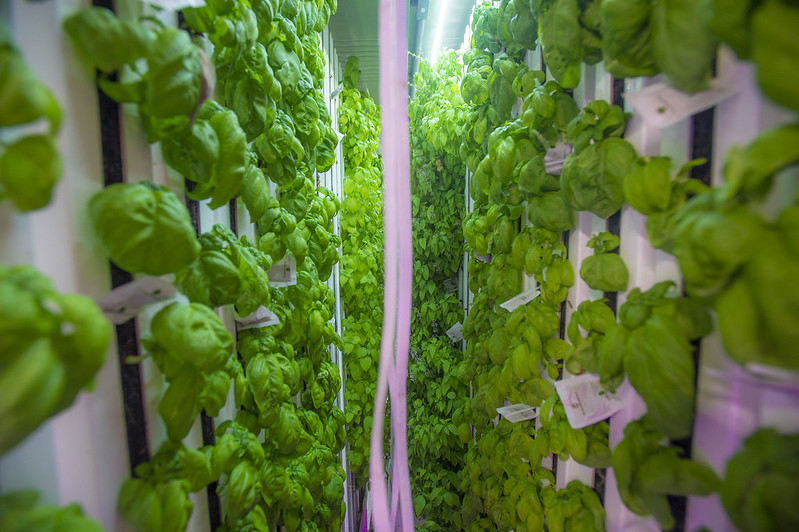
Written by: Becky Anderson
Published by: David Santos
Indoor Farming and Hydroponic Approaches – Which is the one for you?
Are you a farmer who wants to learn more about different controlled-environment agriculture and cultivation approaches? Or maybe a hobbyist who wants to start growing your own crops but you just don’t know where to start? In this post, we will touch on a few different indoor farming techniques and introduce what makes them great options, or not-so-great options, based on your goals!
Greenhouses
We will start off on the traditional route, a greenhouse. A greenhouse is an enclosed space made of glass or plastic to let in natural light. This is a semi-controlled environment with (usually) a single layer of planted crops and is a more traditional form of indoor agriculture. There are many options to choose from when it comes to the size, material, and structure of greenhouses, Figure 1.

Vertical Farms
Next, we head into a more technologically advanced approach, albeit similar to a greenhouse. Vertical farms use trays containing crops that are stacked from floor to ceiling, instead of a single layer, Figure 2. This is a much more controlled environment, containing LED lighting, humidity, and temperature control. Vertical farms are more energetically expensive than greenhouses (6-10x more) but utilize every inch of space.
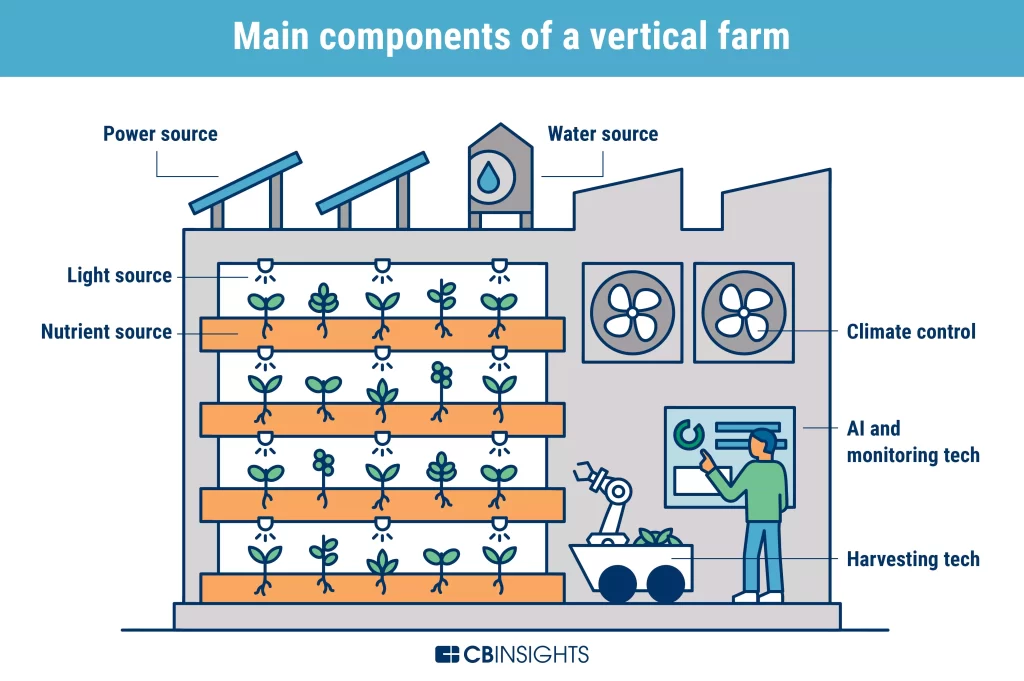
Hydroponic Systems
Hydroponic systems are a technique often used in vertical farms. Hydroponic systems are a form of agriculture that support the growth of plants without using soil. Instead, plants are grown in a nutrient-rich aqueous solution. Much like vertical farms, this is a highly controlled environment (e.g. pH, temperature, humidity, nutrient concentrations, etc.).
Did you know there are six main types of hydroponic systems? (Diagrams are from https://www.nosoilsolutions.com/6-different-types-hydroponic-systems/)
- Wick Systems – Among the simplest hydroponic designs – these systems function without the use of electricity, pumps, or aerators! Water travels up the wick to nourish the plant. Limited nutrients are supplied to the plant, but this system is great for small gardens!

- Water Culture – AKA “Deepwater systems”, are similar to wick systems, but the roots are directly submerged. They also have an air stone or diffuser to oxygenate the water. This system provides substantial nutrient uptake, but there is potential for root disease if the system is not maintained/cleaned properly.

- Ebb and Flow – Also known as “Flood and drain”, are popular hydroponic systems and often require a large set up, due to the spacing of plants. Plants are flooded and drained with nutrient-rich water using a pump. Great for diverse plant types, (e.g. root vegetables) but issues can arise with pump malfunctions.
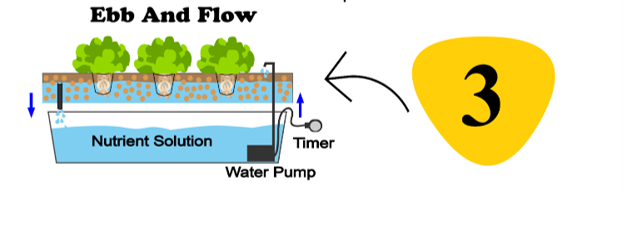
Is this article helpful so far? Subscribe to our newsletter to get more, up-to-date information about pathogens, solutions, and all things regarding indoor farming!
- Drip Systems – These systems are easy to alter based on plant requirements, which is great for farmers looking to switch up their crops from time to time! Nutrient-rich water is pumped directly into the plant base and any excess water will drip out. You can easily scale this system up or down, but nutrient concentration and pH need to be monitored closely.
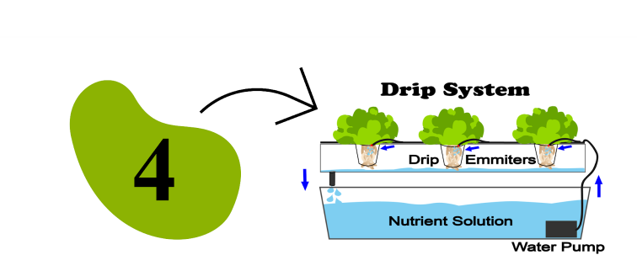
- Nutrient Film Technology – This system scales up well which is perfect for large commercialized farms that require large outputs! In this system, the nutrient-rich water is pumped into sloped channels, with excess solution flowing back into the reservoir. This is a great option for plants with small roots, such as lettuce, kale, or chard.

- Aeroponic Systems – This is a slightly different type of system, where plants are suspended in the air, instead of being suspended in water. Roots are gently misted with a nutrient-rich solution. This system uses the least amount of water, with up to 95% less water than other hydroponic systems. Aeroponic systems can accommodate most plants, but can be expensive and nozzles can get clogged easily.

Aquaponics
Many of the hydroponic systems mentioned above can be used in an aquaponic circuit. This is because aquaponic systems utilize both hydroponics and aquaculture in a closed system, Figure 3. The water that the fish live in is pumped through a bio-filter and is used to support the growth of crops. This water contains high concentrations of ammonia due to the waste produced by the fish, which is an important nitrogen source for plants.
This type of farming has many benefits for both the plants and the fish and is great for conserving water. However close monitoring is required due to the risk of contamination and disease. If there is any contamination, either in the fish pool, tubing, or hydroponic system, the disease can spread quickly and be difficult to eradicate.
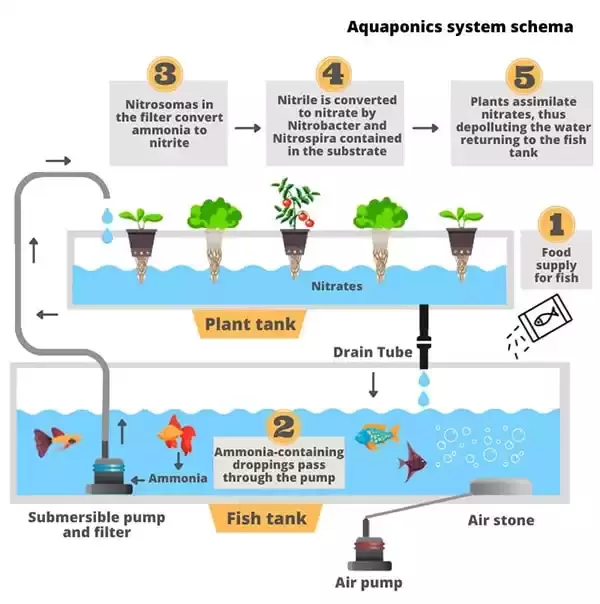
Which approach should you choose?
When choosing an appropriate indoor farming method for your goals, there is no right or wrong answer. Many factors come into play when making the best decision for you and your plants, such as:
Space and Scale:
This is one of the biggest factors to consider when choosing an indoor farming approach. If you have a smaller footprint but want to utilize every inch of space, then a vertical approach may help you reach your goals. If you are starting a vegetable garden at home, you would require a smaller scale setup compared to an industrialized farm producing crops for grocery stores. Your budget will also depend on the size of your farm, and is another factor to consider.
Cost:
When it comes to indoor farming, there is a system for every price range. Many of these systems can be made with objects and tools found around the house if you are interested in a DIY project. However, some can be quite expensive such as vertical farms which require LED lighting and highly controlled water pressure, temperature, pH, and humidity.
Crop variety:
Some crops do really well in hydroponic systems, such as tomatoes, peppers, strawberries, and lettuce. They are small in size and can be spaced closely together. Their roots also do not grow deep, therefore they do not clog the system. Other vegetables such as carrots, potatoes, and radishes would not do well in shallow hydroponic systems because they require a lot of space below the waterline, therefore they would need more depth within a system. Plants which are heavy and grow on vines, such as watermelons and pumpkins would not be ideal for a hydroponic system due to their weight and the amount of space they take up. However, these crops would be great in a greenhouse set up or possibly a vertical farm format.
Environment and Climate:
Most of these systems require highly controlled environments such as vertical farms and hydroponic systems. However, greenhouses can be a little more flexible when it comes to the internal climate. Utilizing the external climate, such as humidity and temperature, can drastically reduce the electricity cost for controlling the internal environment. Keep in mind the time of year you are harvesting, hours and strength of sunlight, amount of rain (you can recycle this) humidity, and temperature, and utilize these to the best of your ability.
Experience and Technical Abilities:
This factor goes hand in hand with space and scale. If you are a one-person grower, then a small setup with less technical and/or experiential demand may suffice. However, if you are wanting to industrialize your farm and produce a consistently high output all year round, you will require a team of growers who likely have different technical abilities and experience. Systems such as aeroponics and aquaponics are more technologically demanding than a simpler set up such as a wick system. Therefore, you will need to keep in mind the level of expertise and technical support required to keep your system running smoothly.
With any of the methods mentioned above, or any additional methods we didn’t touch on, regular maintenance is required. This maintenance can include regular surveillance using our healthy hydroponics surveillance program to ensure your crops stay healthy and happy and make sure you do not incur any financial loss due to plant disease.
Whichever approach you choose, we are here to help you! We want you to succeed in growing healthy crops for your family and community. Check out our Services or send us an email at [email protected] and we will set up a custom surveillance plan to proactively protect your crops against disease.
A healthy family starts with healthy hydroponics!


